Estimated Reading Time [est_time]
During these challenging times, what can business to business (B2B) brands do to make the most of an environment where it feels no one is buying? Once this is clear, doing nothing is not an option.
This post will look at:
- Evaluating where you are
- The changing landscape
- Building a content strategy
- People buy people
- The importance of SEO
- Multilayered content
- Setting KPIs
- Conclusion
When we look back at 2020, there is no denying it will be the year that people will remember as one of the most challenging.
As I write this and speak to colleagues, friends and family, the number one thing that people say is that it has made them think about themselves a lot more, what they do and the world around them.
Evaluating where you are
Survival of the fittest is a terrible term as it’s not always the fittest that survive, it’s normally the smartest and resilient. I wrote about business resilience last week and shared some hints and tips.
So equally, when we look back at this mad year from a business perspective, many will remember confusion; the need for survival as well as the urge to fight. By their very nature, businesses are fighters. We fight to win new business, innovate and look to refine and improve what we do.
There has not been one company that has not been affected by the Coronavirus pandemic and the horrendous implications of Covid-19. Added to this, the lockdown that was implemented some 4-5 weeks ago, showing no sign of abating.
So on that premise, we have to be clear what we say to clients and prospects – more importantly, how we say it. Now more than ever, people are looking for real content with substance. With so much fluff around, there is a perfect opportunity to create impact.
The changing landscape
The world has changed – has your content? Content will play a vital role in B2B marketing. The worrying fact is that many companies are simply turning out the same old tired and hackneyed content that is less than empathetic and certainly not engaging. In many ways, this will hurt their brand.
The reality is that to win in an increasingly competitive B2B marketplace, organisations need to become less precious about the B2B tag and start looking at what makes people engage.
So, how can we start creating great engaging content that will bring us new customers? Let’s start at the beginning and think about the strategy and tactics needed.
Building a content strategy – start by thinking
Strategy without tactics is the slowest route to victory. Tactics without strategy is the noise before defeat.
Sun Tzu, The Art of War
Before we go into the strategy and tactics, let’s think about 6 key areas we may need to focus on and what is important when creating your strategy.
- What problems or pain does my company help alleviate for other companies?
- If you have a content strategy currently, ask yourself – why do I use the strategy I do? Was it there before I started, how do I feel about it?
- What would a successful content strategy look like for me and my organisation?
- Which companies do I admire and the content they produce, why do I find it interesting and engaging?
- How am I measuring content currently? Do I really know what is working?
- How do I currently distribute content? What social channels do I use and which work best?
The process of thinking through and noting down areas that are pertinent is key to help start the process of what is important when looking to create a content plan.
People buy people
The old saying is that people don’t buy companies they buy people. Equally, people don’t buy what you do, they buy into ‘why’ you do it.
These two fundamental points are key in defining a content strategy and should be the underlying key in what you produce.
90% of top-performing B2B content marketers put the audience’s informational needs first.
Content Marketing Institute – 2019 B2B Content Marketing Research
The rise of the “influencer”
The rise of specialists or influencers in marketing has crossed over to B2B. Once the domain for pure B2C, the influencer has always existed in B2B but now has a name.
The person of influence now has an important role in any organisation. They are the go-to people that people both internally and externally turn to when they are looking for help or advice.
Building a personal brand within your organisation allows potential customers to empathise and relate to your product or service.
The Importance of SEO
In the recent and highly respected Content Marketing Institute Research, the leading issue at the top of the list is Search Engine Optimisation or SEO.
It is understandable that SEO is a major concern for content marketing and marketing professionals as the fundamental point is key: there is no point creating content if no-one can find it.

Create Multi Layered Content
There has been a major shift in content marketing recently. People will engage with both text and visual content in different ways. In many cases, an image on LinkedIn for example, will be enhanced by the text that accompanies it – and vice versa.
As people move through the buying cycle and consume different types of content, it is important to have varying types of content to engage with the customer.
Different content types also work differently across different platforms. For example, strong visual content will work better on Instagram compared to the same content working on LinkedIn. Everybody learns differently and will prefer to consume different content mediums, e.g. video, long form content such as blogs, and short form content such as quick LinkedIn posts and comments.
A good way of understanding where your business customers are coming from and moving across your website is Google Analytics.
Once this is understood you can reverse engineer your content and marketing to match user behaviour. An example of a customer journey funnel is below.

Setting KPIs
Benchmarking and measuring is important to evaluate the content that is working well. Though there may be other elements that will determine what proves successful or not, like weather, time of day, world events etc, setting KPIs is the basis of understanding and setting goals.
So what and how do we determine KPIs? As every industry is different, there are no hard and fast rules as to what KPIs to set. It’s best to use a combination as a start point and refine from there. Some areas to look at are:
- Pageviews
- Shares and engagement
- Followers and subscribers
- Audience engagement
- Inbound links
- Number of leads – forms/emails/calls
- Click Through Rate (CTR)
- Cost per lead
- Time on page or dwell time
- Click to conversion
Though the above are not definitive, they are a good starting point.
Conclusion
In conclusion, B2B content needs to be treated like most other content and have a core structure at its heart. That structure should always be:
- Why am I doing this content?
- Does this fit into the larger plan? (e.g. wider business plan or marketing plan/ strategy)
- What do I hope to achieve from this? (goals and objectives)
- How am I measuring it?
- What are my success metrics? (KPIs)
- What happens next?
If we stick to these fundamentals throughout the content planning and execution phase, we have a measurable and tangible asset that can be referred back to. Looking back over a period of time and adding other factors like seasonality and general business sentiment, we can take an intelligent view of what may be working in our content strategy.
If any of these areas are of interest or you would like to learn more about content planning, please feel free to contact the team.






